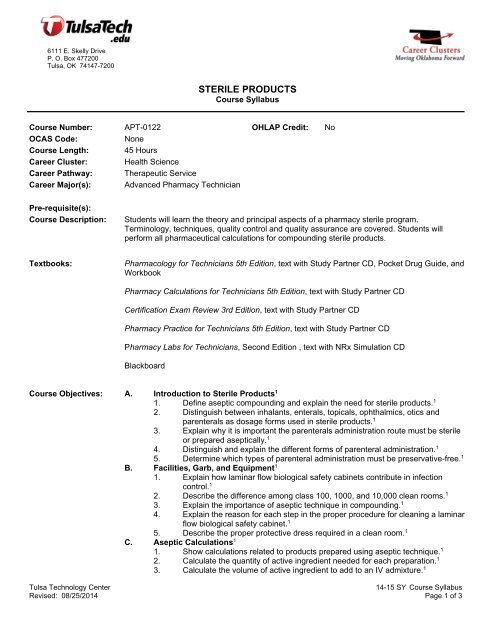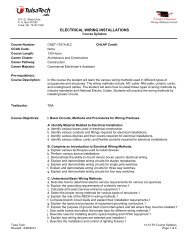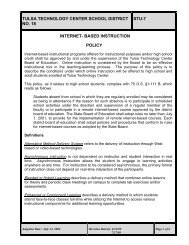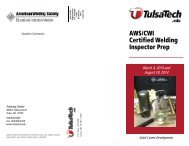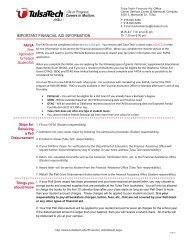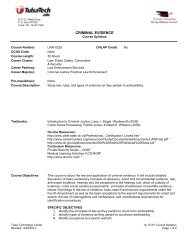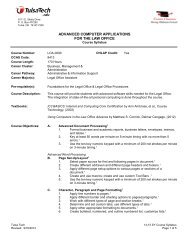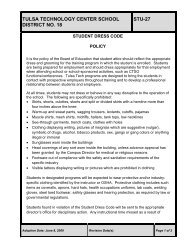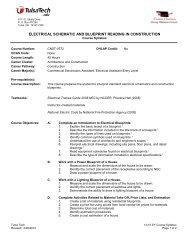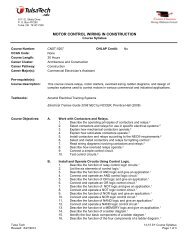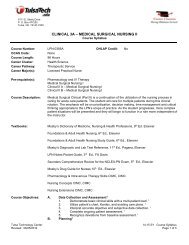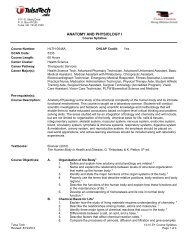Sterile Products - Tulsa Technology Center
Sterile Products - Tulsa Technology Center
Sterile Products - Tulsa Technology Center
You also want an ePaper? Increase the reach of your titles
YUMPU automatically turns print PDFs into web optimized ePapers that Google loves.
6111 E. Skelly DriveP. O. Box 477200<strong>Tulsa</strong>, OK 74147-7200STERILE PRODUCTSCourse SyllabusCourse Number: APT-0122 OHLAP Credit: NoOCAS Code:NoneCourse Length: 45 HoursCareer Cluster: Health ScienceCareer Pathway: Therapeutic ServiceCareer Major(s): Advanced Pharmacy TechnicianPre-requisite(s):Course Description:Students will learn the theory and principal aspects of a pharmacy sterile program.Terminology, techniques, quality control and quality assurance are covered. Students willperform all pharmaceutical calculations for compounding sterile products.Textbooks:Pharmacology for Technicians 5th Edition, text with Study Partner CD, Pocket Drug Guide, andWorkbookPharmacy Calculations for Technicians 5th Edition, text with Study Partner CDCertification Exam Review 3rd Edition, text with Study Partner CDPharmacy Practice for Technicians 5th Edition, text with Study Partner CDPharmacy Labs for Technicians, Second Edition , text with NRx Simulation CDBlackboardCourse Objectives: A. Introduction to <strong>Sterile</strong> <strong>Products</strong> 11. Define aseptic compounding and explain the need for sterile products. 12. Distinguish between inhalants, enterals, topicals, ophthalmics, otics andparenterals as dosage forms used in sterile products. 13. Explain why it is important the parenterals administration route must be sterileor prepared aseptically. 14. Distinguish and explain the different forms of parenteral administration. 15. Determine which types of parenteral administration must be preservative-free. 1B. Facilities, Garb, and Equipment 11. Explain how laminar flow biological safety cabinets contribute in infectioncontrol. 12. Describe the difference among class 100, 1000, and 10,000 clean rooms. 13. Explain the importance of aseptic technique in compounding. 14. Explain the reason for each step in the proper procedure for cleaning a laminarflow biological safety cabinet. 15. Describe the proper protective dress required in a clean room. 1C. Aseptic Calculations 11. Show calculations related to products prepared using aseptic technique. 12. Calculate the quantity of active ingredient needed for each preparation. 13. Calculate the volume of active ingredient to add to an IV admixture. 1<strong>Tulsa</strong> <strong>Technology</strong> <strong>Center</strong>14-15 SY Course SyllabusRevised: 08/25/2014 Page 1 of 3
STERILE PRODUCTS4. Calculate the volume of electrolytes to add to a TPN. 15. Discuss and calculate dilution technique. 1D. Properties of <strong>Sterile</strong> <strong>Products</strong> 11. Explain the cautions associated with microbial contamination. 12. Understand the pH range and why it is important. 13. Understand the concepts of compatibility and stability. 14. Explain the difference between tonicity, osmolarity andosmolality. 15. Know how to calculate the osmolarity of an IV solution. 16.E. Aseptic Technique 11. Define aseptic compounding and explain the need for sterileproducts. 12. Distinguish between inhalants, enterals, topicals, ophthalmics, otics, andarenterals as dosage forms used in sterile products. 13. Explain why it is important that the parenterals administration route must besterile or prepared aseptically. 14. Distinguish and explain the different forms of parenteral administration. 15. Determine which types of parenteral administration must be preservative-free. 1F. <strong>Sterile</strong> Product Preparations 11. List and describe the different types of sterile products. 12. Know the different used for large-volume and small-volume IV bags. 13. Understand the concept of pediatric dosing and realize why sterile productsprepared for this type of patient are different from those for adults. 14. List some specialty protein-based sterile products. 1G. Total Parenteral Nutrition 11. Explain why a patient receives a TPN. 12. List the additives used in making TPN. 13. Explain why the ingredients are necessary in a TPN. 14. Describe how to admix a TPN. 15. Discuss automated mixing equipment. 1H. Chemotherapy 11. Describe what happens with cancer and cells. 12. Explain how cytotoxic agents are used to treat cancer. 13. Explain safety procedures of handling chemotherapy agents. 14. Describe the types of biological safety cabinets. 15. Discuss appropriate procedures for preparing chemotherapy agents. 16. List the hazards involved with preparing chemotherapy agents. 17. Describe how to clean a chemotherapy spill. 1I. Quality Control and Assurance 11. Explain the necessity of quality control. 12. State task that require quality assurance procedures. 13. Help the pharmacist ensure the quality of all pharmaceuticalservices. 14. List the principles of quality assurance to all pharmacyactivities. 15. Discuss the implications of USP Chapter 797. 16. Compare the various risk levels for differing compounded sterile preparationsand the quality-assurance requirements of each. 1J. Process Validation 11. Demonstrate the following skills in the pharmacy setting: 1a. Aseptic Hand Washing 1b. Horizontal Laminar Airflow Hood 1c. Ampule Preparation 1<strong>Tulsa</strong> <strong>Technology</strong> <strong>Center</strong>14-15 SY Course SyllabusRevised: 08/25/2014 Page 2 of 3
STERILE PRODUCTSd. TPN Preparation 1e. Ampule Preparation- Hazardous Drugs 1f. Vial Preparation-Hazardous Drugs 1g. <strong>Sterile</strong> Ophthalmic Solution Preparation 1h. <strong>Sterile</strong> Product Label Preparation 1i. Vertical Laminar Airflow Hood 1Teaching Methods:1ODCTE ObjectiveAll unmarked objectives are TTC instructor developed.The class will primarily be taught by the lecture and demonstration method and supported byvarious media materials to address various learning styles. There will be question and answersessions over material covered in lecture and media presentations. Supervised lab time isprovided for students to complete required projects.Grading Procedures:Description ofClassroom,Laboratories, andEquipment:1. Students are graded on theory and lab practice and performance.2. Each course must be passed with seventy (70%) percent or better.3. Grading scale: A=90-100%, B=80-89%, C=70-79%, D=60-69%, F=50-59%.4. Career Major grades established during coursework are a major criteria in successfullyobtaining certification.<strong>Tulsa</strong> <strong>Technology</strong> <strong>Center</strong> campuses are owned and operated by <strong>Tulsa</strong> <strong>Technology</strong> <strong>Center</strong>School District No. 18. All programs provide students the opportunity to work withprofessionally certified instructors in modern, well-equipped facilities.AvailableCertifications/College CreditThe student may be eligible to take state, national or industry exam after completion of theprogram. College credit may be issued from Oklahoma State University-Okmulgee or <strong>Tulsa</strong>Community College. See program counselor for additional information.College CreditEligibility:The student must maintain a grade point average of 2.0 or better.<strong>Tulsa</strong> <strong>Technology</strong> <strong>Center</strong>14-15 SY Course SyllabusRevised: 08/25/2014 Page 3 of 3


